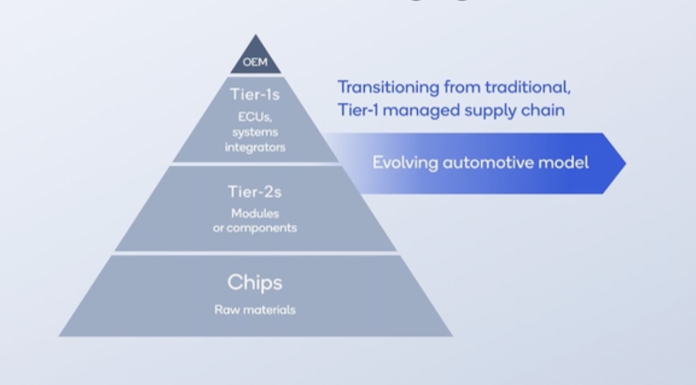As automotive architectures evolve to support electrification, Qualcomm focused on automated driving, digital cockpit and vehicle connectivity
Vehicles are evolving very quickly and along multiple vectors—complex systems of cameras, LIDAR, radar and other sensors are being employed for assisted and autonomous driving; digital cockpits are presenting automakers with the opportunity to provide dynamic, services-oriented and differentiated experiences capable of continuous improvement and refinement; combustion engines are giving way to beds of batteries, inverters and other components of a new electrical architecture. At the core of all these shifts is connectivity, and at the core of connectivity is Qualcomm, which has nurtured its automotive design win to $30 billion as it eyes a $100 billion total addressable market by the end of the decade.
Speaking last month at the Automotive Investor Day event in New York City, Qualcomm SVP and GM of Automotive Nakul Duggal explained, “The change that you’re seeing in automotive today is massive…The OEM’s brand is actually identified by the experience they provide the customer inside the vehicle.” With these factors and the rise of electrification, “I think the key takeaway here is that this [legacy] architecture isn’t really suitable for the car of the future.”
As it works with major automakers across a wide-range of price tiers and geographies, Qualcomm has put together its Snapdragon Digital Chassis encompassing:
- Snapdragon Ride for advanced driver-assistance systems
- Snapdragon Auto Connectivity, including cellular, Wi-Fi and Bluetooth
- Snapdragon Cockpit Platform for in-vehicle virtual assistance, contextual safety, advanced audio, graphics and multimedia
- Snapdragon Car-to-Cloud Services is leveraged for ongoing software updates across a vehicle’s lifecycle
- C-V2X, which is being deployed in China, connects vehicles with pedestrians, other vehicles, cloud services, cellular networks, smart infrastructure–everything really–for enhanced, reliable safety services in support of autonomous driving
- And positioning technologies that support navigation, emergency services, ADAS, C-V2X, autonomous driving, and multi-frequency, multi-constellation GNSS.
Qualcomm began providing modems in the automotive sector in 2002. The company has expanded this line of business over time and incorporated it into it’s “one technology roadmap,” which is all about leveraging core technologies developed for mobile and applying them in other high-growth areas. It’s working to expand its total addressable market seven-fold to $700 billion by 2030 with automotive potentially contributing $100 billion.
Duggal tracked the shift from modems to fully-integrated systems on chip that allow automotive OEMs to stay ahead of functionality requirements. “What we are now starting to see is even a more radical shift where the vehicle is actually getting simplified into physical spaces or zones…You aggregate functionality that is specific for that space in the vehicle…In the center you’re left with driver assistance/automated driving, cockpit systems, connectivity, networking. What this also does is it sets the vehicle up for the right software-defined platform that you need the vehicle to be able to have.”
As automakers become software developers and partner with companies capable of supporting a continuous flow of new services and experiences into vehicles, this gives them the ability to reclaim differentiation in the car and unlock new value from the platform. “We’ve started to see…the tip of the iceberg in terms of what’s possible,” Duggal said. “As technology companies, car companies have to be able to have a set of partners that are different, that are unique.”
Given its relationships with the likes of BMW, General Motors, Great Wall Motor, Honda, Mercedes-Benz and Stellantis, not to mention its significant design win growth, Qualcomm is meeting automakers’ needs for a different, unique partner.

